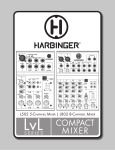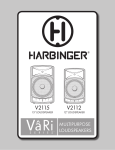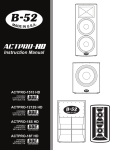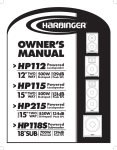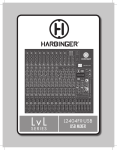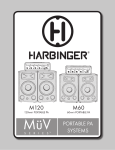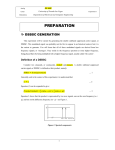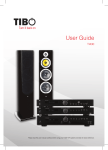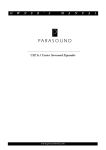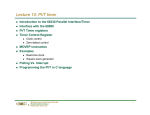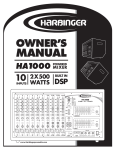Download 10168 Harbinger Lvl L502 802 Manual.indd
Transcript
L502 5-CHANNEL MIXER | L802 8-CHANNEL MIXER 10168 Harbinger Lvl L502 802 Manual.indd 1 7/8/14 3:15 PM 5 & 8-CHANNEL MIXERS IMPORTANT SAFETY INSTRUCTIONS Please keep this instruction manual for future reference and for the duration of owning the LvL mixer. Please carefully read and understand the instructions inside this owner’s manual before attempting to operate your new powered loudspeaker. This instruction manual includes essential safety information regarding the use and maintenance of the amplifier. Take special care to heed all warning symbols and signs inside this manual and those printed on the amplifier on the back of the loudspeaker. WARNING A. T he power supply cord or the plug has been damaged; or B. Objects have fallen, or liquid has been spilled into the product; or C. The product has been exposed to rain; or D. The product does not appear to operate normally or exhibits a marked change in performance; or E. The product has been dropped, or the enclosure damaged. TO PREVENT FIRE OR SHOCK HAZARD, DO NOT EXPOSE THE PRODUCT TO WATER/MOISTURE, NOR SHOULD YOU OPERATE THE PRODUCT NEAR ANY WATER SOURCE. 15. K eep the product out of extended or intense direct sun light. The exclamation point triangular symbol is intended to alert the user to the presence of important operating and maintenance(servicing) instructions in the user manual accompanying the product. 17. S ERVICING – The user should not attempt any service to the product beyond that described in the operating instructions. All other servicing should be referred to qualified service personnel. The lightning flash with an arrow triangular symbol is intended to alert the user to the presence of non-insulated “dangerous voltage” within the product’s enclosure, and may be of sufficient magnitude to constitute a risk of electric shock. 18. V ENTILATION – Slots and openings in the product are provided for ventilation and to ensure reliable operation of the product and to protect it from overheating. These openings must not be blocked or covered. The openings should never be blocked by placing the product on a bed, sofa, rug, or other similar surface. This product should not be placed in a built-in installation such as a bookcase or rack. WARNING Handle the power supply cord with care. Do not damage or deform it as it may cause electric shock or malfunction when used. Hold the plug attachment when removing from wall outlet. Do not pull on the power cord. IMPORTANT SAFETY PRECAUTIONS 1. READ INSTRUCTIONS – All the safety and operating instructions should be read before this product is operated. 2. R ETAIN INSTRUCTIONS – The safety and operating instructions should be retained for future reference. 3. HEED WARNINGS – All warnings on the product and in the operating instructions should be adhered to. 4. FOLLOW INSTRUCTIONS – All operating and use instructions should be followed. 5. DO NOT turn on the product module before connecting all other external devices. 6. WATER AND MOISTURE – Moisture can damage the product and can cause corrosion of electrical contacts. The system should not be used near water - for example, a bathtub, washbowl, kitchen sink, laundry tub, wet basement, or near a swimming pool, and the like. 7. HEAT – The product should be situated away from heat sources such as radiators, heat registers, stoves, or other sources (including amplifiers) that produce heat. 8. POWER SOURCES – This product should be operated only from the type of power source indicated on the rating label. If you are not sure of the type of power supply to your home, consult your product dealer or local power company. 16. N o containers filled with any type of liquid should be placed on or near the product. 19. A TTACHMENTS – do not use attachments not recommended by the product manufacturer, as they may cause hazards. 20. A CCESSORIES – Do not place this product on an unstable cart, stand, tripod, bracket, or table. The product may fall, causing serious injury to a child or adult, and serious damage to the product. Use only with a cart, stand, tripod, bracket, or table recommended by the manufacturer, or sold with the product. 21. LIGHTNING – For added protection during a lightning storm, or when it is left unattended and unused for long periods of time, unplug it from the wall outlet. This will prevent damage to the product due to lightning and power-line surges. 22. R EPLACEMENT PARTS – When replacement parts are required, be sure the service technician has used replacement parts specified by the manufacturer or have the same characteristics as the original part. Unauthorized substitutions may result in fire, electric shock, or other hazards. 23. S AFETY CHECK – Upon completion of any service or repairs to this product, ask the service technician to perform safety checks to determine that the product is in proper operating condition. To prevent electric shock, do not use a polarized plug with an extension cord, receptacle or other outlet unless the blades can be fully inserted to prevent blade exposure. RISK OF RISQUE DE CHOC ELECTRIC SHOCK ELECTRIQUE NE DORISK NOT OF OPEN RISQUE PAS OUVRIR DE CHOC ELECTRIC SHOCK ELECTRIQUE NE DO NOT OPEN PAS OUVRIR 9. GROUNDING OR POLARIZATION – Do not defeat the safety purpose of the polarization or grounding-type plug. The wide blade or the third prong is provided RISKdo OF not RISQUE DE CHOC CAUTION: To reduce the risk of electric shock, for your safety. If the provided plug does not fit your outlet, consult an electrician ELECTRIC SHOCK ELECTRIQUE NE remove chassis. No user-serviceable parts inside. DO NOT OPEN PAS OUVRIR for replacement of the obsolete outlet. Do not defeat the safety purpose of the 3rd CAUTION: To reduce the risk of electric shock, do not Refer servicing to qualified service personnel. remove chassis. No user-serviceable parts inside. pin grounding prong. Refer servicing to qualified service CAUTION: To reduce the risk AVERTISEEMENT: Pour réduire les personnel. risques d’incendie et of electric shock, do not 10. POWER-CORD PROTECTION – Power supply cords should be routed so that they d’électrocution, ne pas exposer cechassis. matérial No à lauser-serviceable pluie ou remove parts inside. are not likely to be walked on or pinched by items placed upon or against them, AVERTISEEMENT: Pour réduire les risques d’incendie et à l’humidité. Refer servicing paying particular attention to the cord in correspondence of plugs, convenience d’électrocution, ne pas exposer ce matérialtoàqualified la pluie ouservice personnel. receptacles, and the point where they exit from the product. à l’humidité. AVERTISEEMENT: Pour réduire les risques d’incendie et 11. CLEANING – The product should be cleaned only as recommended by d’électrocution, ne pas exposer ce matérial à la pluie ou the manufacturer. Clean by wiping with a dry cloth. Avoid getting water inside à l’humidité. the product. THIS SYMBOL IS INTENDED TO ALERT THE USER TO THE PRESENCE 12. NON-USE PERIODS – The power cord of the product should be unplugged from OF IMPORTANT OPERATING AND MAINTENANCE (SERVICING) the outlet when left unused for a long period of time. INSTRUCTIONS IN THE LITERATURE ACCOMPANYING THE UNIT. 13. OBJECT AND LIQUID ENTRY – Care should be taken so that objects do not fall and liquids are not spilled into the enclosure through openings. 14. D AMAGE REQUIRING SERVICE – The product should be serviced by qualified service personnel when: 2 10168 Harbinger Lvl L502 802 Manual.indd 2 APPARATUS SHALL NOT BE EXPOSED TO DRIPPING OR SPLASHING AND THAT NO OBJECTS FILLED WITH LIQUIDS, SUCH AS VASES, SHALL BE PLACED ON THE APPARATUS. L502 & L802 Owner's Manual 7/8/14 3:15 PM 5 & 8-CHANNEL MIXERS TABLE OF CONTENTS Quick Start 4 Glossary of Terms 11 What's on the Front Panel 6 Cable Diagrams 12 Input Types 8 Block Diagram 13 Output Types 10 Mixer Specifications 15 Troubleshooting 10 Warranty/FCC Statements 16 WELCOME Congratulations on your recent purchase of a new Harbinger LvL Series mixer. They are the perfect choice for bands or individual musicians who are looking for great-sounding mixes, live performance durability and audio specs that studio users demand. To get the most out of your new mixer, we suggest that you read through this entire manual at least once, then refer back to it as needed. L502 & L802 Owner's Manual 10168 Harbinger Lvl L502 802 Manual.indd 3 3 7/8/14 3:15 PM 5 & 8-CHANNEL MIXERS QUICK START STUDIO QUICK START – PLUG IN A MICROPHONE AND HEAR IT THROUGH HEADPHONES Before we go through each feature on the mixer, we'll show a few common setups so that you can begin using your mixer right away. In the first example, we’re going to connect a microphone and listen to it through headphones. Be sure to follow the directions so that you don’t hear loud feedback through your speakers! 1. Turn the PHONES knob all the way down, and the GAIN control on channel 1 (top left) all the way down. 2. Plug your headphones into the PHONES OUT. 3. Turn the LEVEL control on channel 1 up about half way. on your microphone. If it says “condenser” then Phantom Power should be switched on. If it says “dynamic” then leave it off, although phantom power won't damage a dynamic mic. • Are the level and gain knobs turned up on channel 1? Are the Main Mix and PHONES levels turned up? • Make sure that the PAN control is in the center. • If the meters above Main Mix are moving, then your problem is with the headphones. If the meters aren’t moving, something isn’t set correctly on the mixer. 4. Plug your microphone into the MIC input on channel 1. 5. If you’re using a condenser microphone, switch on the PHANTOM POWER function. If you’re using a dynamic mic, or don’t know which type you’re using, leave phantom power off. PLAY BACK FROM YOUR COMPUTER OR PORTABLE DEVICE 6. Turn the MAIN MIX up ½ way. Next, we're going to play back from a line level device like a computer, smartphone, keyboard, or MP3 player. 7. Turn the GAIN control on channel 1 up about ½ way. If the PEAK light flashes red, turn the gain back down a bit. 1. If still set up as above, turn down the LEVEL control on channel 1. Keep the Main Mix and Control Room levels up. 8. Slowly turn up the PHONES level while speaking into the microphone. 2. Turn down the Level control for stereo channel 3-4 (2-3 on L502). You should hear your voice through the headphones. Don’t hear anything? Here are a few things to check: 3. Plug your computer, smartphone, keyboard, or MP3 player into the LINE INPUT for channels 3-4 (2-3 on L502). You'll need ¼" cables, either balanced or unbalanced will work. • Do you need to switch phantom power on? Look at the markings 4. Turn up the Level for channels 3-4 (2-3 on L502). 4 10168 Harbinger Lvl L502 802 Manual.indd 4 L502 & L802 Owner's Manual 7/8/14 3:15 PM 5 & 8-CHANNEL MIXERS * LIVE SOUND QUICK START – PLUG IN A MICROPHONE AND HEAR IT THROUGH YOUR PA SPEAKERS Here is a typical live sound setup using two microphones, a stereo PA, and an on-stage floor monitor. 1. Turn the MAIN MIX fader (bottom right) all the way down, and the GAIN control on channels 1 and 2 (top left) all the way down. 2. Plug your speakers into the MAIN OUT left and right. Switch on the power amp. 3. Turn the LEVEL control on channel 1 up about half way. 4. Plug a microphone into the MIC inputs on channels 1 and 2. 5. If you’re using a condenser microphone, switch on the PHANTOM POWER function. If you’re using a dynamic mic, or don’t know which type you’re using, leave phantom power off. 6. Turn the MAIN MIX fader up ½ way. 7. Slowly turn the GAIN control on channel 1 up to about ½ way. Watch the meters above the main fader. If they go up to 0, or if the PEAK light flashes red on your channel, turn the gain back down a bit. 8. Slowly turn up the GAIN on channel 2. 9. *Switch on your stage monitor. Turn up the AUX knob on any channel you want to hear on stage. Remember that the more microphones and speakers you use, the more possibilities there are for feedback. *L802 ONLY L502 & L802 Owner's Manual 10168 Harbinger Lvl L502 802 Manual.indd 5 5 7/8/14 3:15 PM 5 & 8-CHANNEL MIXERS WHAT'S ON THE FRONT PANEL M L502 L502 1 H I J K O 3 A N 2 C 4 5 8 E L F P G INPUT/OUTPUT JACKS: 1 Mic Input: XLR connector for a microphone-level signal. This input also sends phantom power to a microphone when Phantom Power is switched on. 2 Line Input: A ¼" input that accepts a line-level signal. Either a balanced (TRS) or unbalanced (TS) cable can be plugged in here. 3 Gain Control: Controls the input gain for the selected channel, from either the mic or line input. 5 Main Out: Outputs controlled by the Main Mix fader. 6 Control Room Out*: Outputs controlled by the Control Room/ Phones knob. 7 Aux Send*: Output can be connected to a stage monitor or effects processor 8 Phones Out: Stereo output for driving a pair of headphones. The output level is controlled by the Control Room/ Phones knob. 4 Left/Mono Line Input: When this input is used and not the input below, it is sent to both the left and right outputs of the stereo channel. If L and R are both used, a stereo signal is sent to the Main Out. CONTROL SECTION: A High EQ: Controls a high shelving EQ, boosting or cutting E Pan: Sends the channel to the left output, right output, or some- B Mid EQ*: A peaking EQ control, boosting or cutting frequen- F Level: Controls the level of the channel going to the C Low EQ: Controls a low shelving EQ, boosting or cutting G Balance: Works in a similar way to a pan control, it turns down D Aux*: A post-fader auxiliary send. It sends the channel to the H Aux RCA Input: An unbalanced input for a mixdown recorder, frequencies from 12kHz and above cies centered around 2.5kHz frequencies 80Hz and below Aux Send output. where between. Main outputs. one side or the other of the stereo input. MP3 player, computer or other playback source. *L802 ONLY 6 10168 Harbinger Lvl L502 802 Manual.indd 6 L502 & L802 Owner's Manual 7/8/14 3:15 PM 5 & 8-CHANNEL MIXERS I Aux RCA Output: Unbalanced output is useful to send to a recorder, such as a portable recorder or computer to record a live performance. J To Mix: Sends the Aux RCA Input to the Main outputs for live sound applications. K To Phones (Control Room*): Sends the Aux Input to the headphones and control room outs L Control Room*/Phones level: Controls the level going to the Control Room* outputs and the Phones outputs. N Meter: Shows the signal level being sent to the Main Outs. If the red 0 or +5 lights are on, the output is being distorted. O Power LED: Shows that the mixer is switched on. P Main Mix: Sets the level to the Main Outs. Q Aux Send Master: The Aux Send master is the master output volume for the individual Aux Sends per each channel. This control must be turned up for individual channel Aux signals to pass to the Aux Output. M Phantom Power: Sends (L802 +48V, L502 +15V) phantom power to the XLR inputs. L802 1 2 7 3 8 4 L802 J K 6 5 H I A B C O D N Q E G M F P L *L802 ONLY L502 & L802 Owner's Manual 10168 Harbinger Lvl L502 802 Manual.indd 7 7 7/8/14 3:15 PM 5 & 8-CHANNEL MIXERS INPUT TYPES This chapter will review the types of inputs on the L502/802 mixer and explain each of their features. CHANNELS 1-4: MIC/LINE INPUTS MICROPHONE INPUT (MIC) Use the microphone preamp's gain control (explained below) to bring the microphone up to a high enough level to use with the mixer. LINE INPUT (LINE) This ¼" input is designed for line-level signals. It accepts either balanced (TRS) or unbalanced (TS) cables. The level of this input is also controlled by the gain control, explained below. Do not use both the microphone and line inputs on the same channel. The mixer will distort and the noise level will go up. The line input is not designed to accept an instrument-level signal, such as the output from an electric or acoustic guitar or bass. If you want to plug your instrument into the mixer, we suggest a direct box (also called a DI box). Plug your instrument into the direct box, then plug the output of the direct box into the microphone input of the mixer. GAIN Gain controls the level of the microphone or line level signal plugged into the mixer. If the gain is set too low, the output signal will be noisy when you turn it up at the level control. If gain is set too high, it will distort. For best performance, set the gain while looking at the meters. Turn the Level control so that it's facing straight up. Then turn the gain up until you see the first or second lights on the meters. Don't set it too high – although you might not hear distortion when playing by itself, when all of the channels are playing at that level they may add together and distort the mixer. Sidebar: "Why are there two volume controls?" The Gain and Level controls work together to get the best performance out of the mixer. A quiet signal may need more gain than a loud guitar amp going into a sensitive RELATIVE RESPONSE IN dB FREQUENCY RESPONSE FREQUENCY IN HZ The high EQ control is a shelving EQ. What this means is that it boosts or cuts from 12kHz and everything above that. Turn it up to bring out the breath of a vocal or the high overtones of the cymbals. Turn it down to reduce finger squeaks on a guitar or bass. EQ MID* RELATIVE RESPONSE IN dB Some microphones, mostly condenser mics, need phantom power to operate. Switch on phantom power on the right side of the mixer. If you're unsure if your mic needs phantom power, check the instructions or the manufacturer's website for information. Phantom power should not hurt most microphones, except for very old or damaged ribbon microphones. EQ HI FREQUENCY RESPONSE FREQUENCY IN HZ The mid EQ is a peaking EQ, centered at 2.5kHz. This boosts or cuts the high midrange of your signal. You might turn it up if your vocal isn't cutting through the mix, or turn it down if a percussion part is too harsh. EQ LOW RELATIVE RESPONSE IN dB This XLR connector will accept virtually any professional microphone. It is designed for microphone level signals. If you have a device that plugs into the wall and has an XLR output (like a mic pre/channel strip, guitar multieffects processor, computer interface), you should get an XLR-to-¼" TRS cable and plug it into the line input (below). microphone. Set the gain so that the level on each channel is roughly the same, then use the Level controls to set the balance that you want in your mix. FREQUENCY RESPONSE FREQUENCY IN HZ This low EQ boosts or cuts everything from 80Hz or below. You might bring it up for more bottom out of your kick or bass guitar, and turn it down to reduce rumble from a vocal or wind instrument. *L802 ONLY 8 10168 Harbinger Lvl L502 802 Manual.indd 8 L502 & L802 Owner's Manual 7/8/14 3:15 PM 5 & 8-CHANNEL MIXERS AUX SEND* The Aux Send is separate buss on the L802 mixer. This means that you can have a different mix on the aux buss than you do on the main outputs. This comes in handy in a few scenarios: • Sending different amounts to the effects section, so that some instruments have more reverb than others • Setting up a headphone mix, so that a recording musician can hear exactly what they want while you listen to your own mix • Creating a monitor mix on stage, so that band members can hear what they need to perform while you mix for the rest of the club The L802's Aux Send is post fader. This means that if the Level is turned all the way down, you can't send anything to the aux buss. The aux send can be sent to different parts of the mixer, depending on what application you need it for. It always shows up at the Aux Send output of the mixer, and you might plug that into the input of a stage monitor or external effects processor. It also gets sent to the internal effects processor. Finally, you can send it to the Control Room and headphone outputs by pressing the "Aux Send To Phones" button, next to the Control Room/Phones level control. This allows a musician to hear their own mix while recording with headphones. If you would like to listen to a different mix through the Control Room than your artist on headphones, you will need to plug the Aux out into a headphone amplifier for the artist while you monitor the main mix. PAN The Pan control moves the signal between the left and right outputs. When turned fully to the left, that channel will only show up on the left main output. When turned to the center, it will be send in equal volume to the left and right outputs. Turned fully to the right, you will only hear it through the right output. Tip: You can use the pan control to create two mono mixes from the L502/802. This might be more useful than a stereo mix in a large club, house of worship, conference room, or other special application. PEAK The Peak LED lights up when the level coming into that channel is too loud. If you see this light flash, turn that channel's Gain control down and the Level control up. CHANNELS 5-12: STEREO LINE INPUTS RCA INPUT LEFT/MONO INPUT This ¼" input expects a line level signal. It accepts either balanced (TRS) or unbalanced (TS) ¼" cables. If only the Left/Mono input is used on a channel, that signal will be sent to the left and right outputs. If the Right input is also used, this input will be sent to the left output. RIGHT INPUT As above, this is a line level input, either balanced or unbalanced. It is sent to the right output. AUX SEND* This sends the channel to the aux buss. See the previous section for more information. BALANCE (BAL) The Balance knob has a similar effect to the pan control explained in the previous section. But the Balance control just turns down one input or the other. As you turn Balance to the right, the signal coming into the Left/Mono input gets softer. This allows you to control the panning in your mix without collapsing the stereo width of the input. LEVEL This controls the level of the channel going to the Main Outs. See the previous section for more information. The Aux RCA Inputs are a pair of unbalanced RCA phono line inputs. They can be used for a variety of applications: • Monitoring a mixdown recorder. Since these inputs aren't sent to the Main Outputs, there is no chance of a feedback loop. • Playing an MP3 player through the PA between band sets, muting all microphones • Sending a signal to the headphone outputs but not to the main outputs. You might plug a set of outputs from a computer interface into these inputs, so that the metronome click can be sent to the headphones but not the main out. There are two buttons that control where these inputs are heard. One is Aux RCA To Mix and the other is Aux RCA To Phones (Cntl Room.*) When AUX RCA TO MIX is switched on, all of the inputs are muted except for the Aux RCA input. All that you will hear from the L/R outputs is what is playing into the Aux RCA input. You might use this in the example above to play an MP3 player to the PA between sets. Pressing AUX RCA TO PHONES/CONTROL ROOM* means that only the Aux RCA input is heard through the Control Room* and Phones outputs. This is useful if you are recording the mix and only want to hear what is coming back from the recorder. This ensures that the recorder is getting the mix that you expect to hear. It also allows you to monitor the recorder output without creating a feedback loop in the speakers. *L802 ONLY L502 & L802 Owner's Manual 10168 Harbinger Lvl L502 802 Manual.indd 9 9 7/8/14 3:15 PM 5 & 8-CHANNEL MIXERS OUTPUT TYPES This chapter explains each of the outputs on the Harbinger L502/802 mixer and their level controls. MAIN OUTS when preparing a headphone mix for an artist. The Main Outs are line outputs. They will work with either balanced or unbalanced cables. The Main Mix fader controls the level of the Main Outputs. You might plug the main outs into a PA amplifier or a mixdown recorder. PHONES All of the channels should show up at the Main outputs. If they don't, make sure that the "Aux RCA to Mix" button isn't pushed. CONTROL ROOM OUTPUTS (CNTL RM OUT)* The Control Room Outputs are a separate set of outputs for the mixer to listen to. In a home studio, you might plug these into a set of powered studio monitors. The Cnrl Rm|Ph knob controls the level going to the control room outputs (and the headphones.) There are three sources that can be sent to the Control Room Outputs. Usually, you listen to the same mix that's coming out of the Main Outs. If the Aux RCA to Phones (Control Room) button is pressed, only the Aux RCA input will be heard through the Control Room outputs. If the Aux Send to Phones (Cntl Room) is pressed down, the aux send will be heard through the Control Room outputs. This can be useful This is a headphone-level output. It is designed to drive a pair of headphones with a balanced ¼" connector. If your headphones have a 1/8" stereo jack, you will need an adapter to plug them into the mixer (included with most professional headphones.) Note that the headphones and the control room outputs are linked – both the mix and level. If you press Aux RCA to Phones (Cntl Rm), the Aux RCA input will be sent to both the control room outs and the headphones. If you turn the control room level all the way down, there will be no signal in the headphones. AUX SEND* This jack sends the aux buss out of the mixer. Turn up the Aux knob on any channel to send it to the Aux Send output. See page 9 for more information about the aux buss. AUX RCA OUTPUT This is a pair of unbalanced line level outputs. They are just a copy of the Main Outputs. If you turn the Main Mix fader down, the level is also reduced here. TROUBLESHOOTING In this chapter, we'll discuss common problems and their solutions, as well as who to contact if things go wrong with your mixer. TROUBLESHOOTING MATRIX You can hear everything, but it's very noisy. A microphone is plugged in, but you don't see any level on the main meters. • Are all of the level controls turned up very high? Try turning those down and the gain controls up. • Are the Gain and Level knobs turned up? • Try turning down channels one at a time. If there is one channel that is contributing most of the noise, try fixing that at the source. • Is the Main Mix fader turned up? • Is the Aux RCA to Mix, Aux RCA to Phones, or Aux to Phones button pressed in? • If the mic needs phantom power, is the phantom power turned on? (Try it if you aren't sure.) • Try a different microphone cable and/or microphone. • Check the power connections, your power strip, extension cords, etc. You can see level on the meters, but can't hear anything through the control room* speakers. • Is the Aux to Phones/Control Room* or Aux RCA to Phones/ Control Room button pressed in? • Are the monitors switched on? • If only one output is working, try switching the left and right outputs. If the same channel isn't working, the problem is with the speaker. *L802 ONLY 10 10168 Harbinger Lvl L502 802 Manual.indd 10 L502 & L802 Owner's Manual 7/8/14 3:15 PM 5 & 8-CHANNEL MIXERS GLOSSARY OF TERMS BALANCED PHANTOM POWER A 3-conductor (including shield), low-impedance connection. Balanced cables are the preferred method for hum-free interconnection of a sound system for their noise-rejection characteristics. (Also see Unbalanced.) A voltage signal that runs through a microphone cable to power condenser microphones. Harmless to microphones that don't need it, except for very old and/or damaged ribbon microphones. BUSS An output destination in a mixer. For example, the left and right main outputs are called busses, because you can send a channel to one or both of them. Also spelled Bus. CHANNEL One of any number of signal paths in an audio circuit, such as input channel, output channel, recording channel, left channel, right channel, etc. DECIBEL (DB) A term representing the ratio between different audio levels. It can either refer to the electrical signal running through a channel or the acoustic sound level coming from a sound source. EQUALIZATION Electronic filters that adjust the level of certain frequencies. Used for tone enhancement or to reduce extraneous sounds. Two types of EQ shapes are Peak and Shelving, described below. IMPEDANCE Resistance in an electrical circuit measured in Ohms (Ω). Maintaining proper impedance (between amplifier and speakers for example) is important to prevent damage to the amp. PEAK EQUALIZER CONTROL Increase or decrease of a frequency range centered at a specific point, resulting in an EQ curve that looks like a hill (increase) or a valley (decrease). (Compare to Shelving Equalizer Control; see pages 8-9 for more information.) L502 & L802 Owner's Manual 10168 Harbinger Lvl L502 802 Manual.indd 11 REVERB An audio effect that emulates the echo reflections and decay time of a large space. SHELVING EQUALIZER CONTROL Increase or decrease of all frequencies above or below a specific point. (Compare to Peak Equalizer Control; see pages 8-9 for more information.) TRS Acronym for Tip-Ring-Sleeve — the three parts of a three-conductor (including shield) audio plug. TRS phone plugs are often used for “balanced” mono connections, or stereo "unbalanced" (headphone) connections. TS Acronym for Tip-Sleeve, the two parts of an unbalanced, twoconductor (including shield) phone plug. TS connectors are sometimes called mono or unbalanced plugs or jacks. UNBALANCED A two-conductor (including shield), high-impedance connection. These are most commonly used for instrument connections and cable runs of less than 20 feet. XLR The three-pin connector universally used for balanced audio connections. A balanced connection reduces outside noise and interference. (See Balanced above.) 11 7/8/14 3:15 PM 5 & 8-CHANNEL MIXERS CABLE DIAGRAMS BALANCED CABLE + Positive – Negative S-Shield + Positive – Negative S-Shield XLR-M 2 1 3 XLR-F 1 1. Shield 2. Positive 3. Negative TRS 2 S R 3 T T Positive R Negative S-Shield UNBALANCED CABLE + Positive + Positive S-Shield S-Shield RCA 2 TS 1 1. Center 2. Shield UNBALANCED STEREO T Positive Left R Negative Right S-Shield 12 10168 Harbinger Lvl L502 802 Manual.indd 12 S R T L502 & L802 Owner's Manual 7/8/14 3:15 PM 5 & 8-CHANNEL MIXERS BLOCK DIAGRAM - L502 MIC IN LINE IN LINE IN LEFT (MONO) PHANTOM +15 VDC GAIN LOW HIGH PEAK 12K 80 SHELVING EQ LEVEL LEVEL PAN PAN L R L R L R MAIN MIX METER AUX RCA TO PHONES AUX RCA TO MIX PHONES LEFT MAIN MIX OUT RIGHT MAIN MIX OUT LEFT RIGHT CD/AUX RCA OUT LEFT RIGHT CD/AUX RCA IN HEADPHONE OUTPUT 7/8/14 3:15 PM 10168 Harbinger Lvl L502 802 Manual.indd 13 13 L502 & L802 Owner's Manual STEREO CHANNELS 2/3 and 4/5 LINE IN RIGHT LEFT MAIN BUS RIGHT MAIN BUS 5 & 8-CHANNEL MIXERS BLOCK DIAGRAM - L802 MONO CHANNELS 1 and 2 MIC IN LINE IN LINE IN LEFT (MONO) STEREO CHANNELS 3/4 and 5/6 LINE IN RIGHT PHANTOM +48 VDC LOW 80 2.5K 12K EQ MID HIGH GAIN LOW 80 MID HIGH PEAK 2.5K 12K EQ PEAK AUX RETURN TO MAIN MIX LEVEL LEVEL PAN AUX PAN AUX L R L R L R L R LEVEL MAIN MIX METER AUX RCA TO MIX AUX RCA TO CTRL RM/ PHONES CONTROL ROOM/ PHONES LEFT MAIN MIX OUT RIGHT MAIN MIX OUT LEFT RIGHT CD/AUX RCA OUT LEFT RIGHT CD/AUX RCA IN LEFT RIGHT CONTROL ROOM OUTPUTS HEADPHONE OUTPUT AUX SEND 7/8/14 3:15 PM 10168 Harbinger Lvl L502 802 Manual.indd 14 L502 & L802 Owner's Manual 14 AUX RETURNS AUX RETURN LEFT (MONO) AUX RETURN RIGHT LEFT MAIN BUS RIGHT MAIN BUS AUX BUS 5 & 8-CHANNEL MIXERS MIXER SPECIFICATIONS Parameter Condition PAM 502 PAM 802 PAM1202FX Frequency response Mic In to Main Out (Trim at 0 dB): 10Hz - 22kHz +0 -1dB 10Hz - 22kHz +0 -1dB 10Hz - 22kHz +0 -1dB THD Mic In to Main Out, 20Hz to 20kHz 0.008% 0.013% 0.007% Preamp Noise (EIN) 20 Hz to 20 kHz, (150Ω source) -118 dB -118 dB -114 dB Residual Output Noise All level controls @ minimum -87 dB -88dB -95dB Common Mode Rejection Ratio (CMRR) Maximum Gain >50dB @ 1kHz >50dB @ 1kHz >50dB @ 1kHz Crosstalk Adjacent channels -36dB -36dB -36dB Same channel (stereo separation) -88dB -82dB -70dB 0 dB to +50 dB 0 dB to +50 dB 0 dB to +50 dB Input Gain Control Range Phantom Power DC +15V +48V +48V Equalization Mono Channel, High ±15 dB @ 12 kHz ±15 dB @ 12 kHz ±15 dB @ 12 kHz Mono Channel, Mid n/a ±15 dB @ 2.5 kHz ±15 dB @ 2.5 kHz Mono Channel, Low ±15 dB @ 80 Hz ±15 dB @ 80 Hz ±15 dB @ 80 Hz Stereo Channel, High n/a ±15 dB @ 12 kHz n/a Stereo Channel, Mid n/a ±15 dB @ 2.5 kHz n/a Stereo Channel, Low n/a ±15 dB @ 80 Hz n/a Output Level Maximum +20 dBu +20 dBu +20 dBu Maximum Input Levels Mic +12 dBu, Gain @ +10 dB +12 dBu, Gain @ +10 dB +12 dBu, Gain @ +10 dB Line Input +20 dBu, Gain @ +10 dB +20 dBu, Gain @ +10 dB +20 dBu, Gain @ +10 dB Aux RCA Input and Aux +20 dBu +20 dBu +20 dBu Mic Input 2.6 kΩ, balanced 2.6 kΩ, balanced 2.6 kΩ, balanced Line Input 20 kΩ, balanced 20 kΩ, balanced 20 kΩ, balanced Stereo Aux Returns 20 kΩ, balanced 20 kΩ, balanced 20 kΩ, balanced CD/Aux RCA In 24 kΩ, unbalanced 24 kΩ, unbalanced 24 kΩ, unbalanced Main 240 Ω, balanced / 120 Ω, unbalanced 240 Ω, balanced / 120 Ω, unbalanced 240 Ω, balanced / 120 Ω, unbalanced Ctrl Room, Aux Sends 120 Ω 120 Ω 120 Ω Aux RCA Output 1 kΩ 1 kΩ 1 kΩ Return Input Impedance Output Impedance Phones Output 25 Ω 25 Ω 25 Ω VU Meters 5 Segments Clip (+18), +6, 0, -20 dB Clip (+18), +6, 0, -20 dB Clip (+18), +6, 0, -20 dB AC Power Requirements 3-pin AC Mini XLR connector 22 VAC _ 2 @ 350mA 22 VAC _ 2 @ 350mA 22 VAC _ 2 @ 350mA Dimensions WxDxH (mm) 152x198x60 212x255x60 304x255x60 Weight (net) without PSU 0.85 kg 1.45 kg 2.10 kg L502 & L802 Owner's Manual 10168 Harbinger Lvl L502 802 Manual.indd 15 15 7/8/14 3:15 PM 5 & 8-CHANNEL MIXERS WARRANTY Have a question about service, warranty or parts? Call 888-286-1809 (Toll Free) So we may serve you better, please register o n-line at www.HarbingerProAudio.com 2 YEAR HARBINGER LIMITED WARRANTY For warranty support, please visit our website at www.HarbingerProAudio.com, or contact our Support Team at 888-286-1809 for assistance. Harbinger will repair or replace the unit at Harbinger’s discretion. warranty and the implied warranties of merchantability and fitness for a particular purpose are limited to the two (2) year warranty period. Some states do not allow limitation on how long an implied warranty lasts, so the above limitation may not apply to you. There are no express warranties beyond those stated here. In the event that applicable law does not allow the limitation of the duration of the implied warranties to the warranty period, then the duration of the implied warranties shall be limited to as long as is provided by applicable law. No warranties apply after that period. This warranty does not cover service or parts to repair damage caused by neglect, abuse, normal wear and tear and cosmetic appearance to the cabinetry not directly attributed to defects in materials or workmanship. Also excluded from coverage are damages caused directly or indirectly due to any service, repair(s), or modifications of the cabinet, which has not been authorized or approved by Harbinger. This two (2) year warranty does not cover service or parts to repair damage caused by accident, disaster, misuse, abuse, burnt voice-coils, over-powering, negligence, inadequate packing or inadequate shipping procedures. Retailer and manufacturer shall not be liable for damages based upon inconvenience, loss of use of product, loss of time, interrupted operation or commercial loss or any other incidental or consequential damages including but not limited to lost profits, downtime, goodwill, damage to or replacement of equipment and property, and any costs of recovering, reprogramming, or reproducing any program or data stored in equipment that is used with Harbinger products. This guarantee gives you specific legal rights; you may have other legal rights, which vary from state to state. The sole and exclusive remedy of the foregoing limited warranty shall be limited to the repair or replacement of any defective or non-conforming component. All warranties including, but not limited to, the express Harbinger P.O. Box 5111, Thousand Oaks, CA 91359-5111 Harbinger provides, to the original purchaser, a two (2) year limited warranty on materials and workmanship on all Harbinger cabinets, loudspeaker and amplifier components from the date of purchase. All trademarks and registered trademarks mentioned herein are recognized as the property of their respective holders. FCC STATEMENTS 1. Caution: Changes or modifications to this unit not expressly approved by the party responsible for compliance could void the user’s authority to operate the equipment. 2. Note: This equipment has been tested and found to comply with the limits for a Class B digital device, pursuant to Part 15 of the FCC Rules. These limits are designed to provide reasonable protection against harmful interference in a residential installation. This equipment generate, uses, and can radiate radio frequency energy and , in not installed and used in accordance with the instructions, may cause harmful interference to radio communications. However, there is no guarantee that interference will not occur in a particular installation. If this 16 10168 Harbinger Lvl L502 802 Manual.indd 16 equipment does cause harmful interference to radio or television reception, which can be determined by turning the equipment off and on, the user is encouraged to try to correct the interference by one or more of the following measures: • Reorient or relocate the receiving antenna • Increase the separation between the equipment and receiver • Connect the equipment into an outlet on a circuit different from that to which the receiver is connected • Consult the dealer or an experienced radio/TV technician for help L502 & L802 Owner's Manual 7/8/14 3:15 PM

















